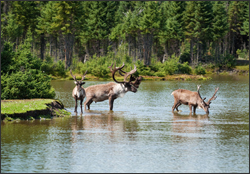Source: Global Forest Watch Canada
 At the International Society of Conservation Biology Conference in Auckland, New Zealand, representatives from the Grand Council of the Crees (Eeyou Istchee) in Quebec Canada today presented dramatic scientific evidence produced by Global Forest Watch Canada of increasing rates of logging and road building in sensitive caribou habitat in Quebec. Critical woodland caribou habitat in the James Bay region of northern Quebec is being rapidly impacted by roads and logging, according to research conducted by Global Forest Watch Canada and commissioned by the Grand Council of the Crees (Eeyou Istchee).
At the International Society of Conservation Biology Conference in Auckland, New Zealand, representatives from the Grand Council of the Crees (Eeyou Istchee) in Quebec Canada today presented dramatic scientific evidence produced by Global Forest Watch Canada of increasing rates of logging and road building in sensitive caribou habitat in Quebec. Critical woodland caribou habitat in the James Bay region of northern Quebec is being rapidly impacted by roads and logging, according to research conducted by Global Forest Watch Canada and commissioned by the Grand Council of the Crees (Eeyou Istchee).
Isaac Voyageur, a Cree from Quebec said, “The Grand Council of the Crees came to this important conference in order inform the international community engaged in Conservation Biology about our work and more importantly, the precarious situation of the woodland caribou in Eeyou Istchee.”
“We conducted this study, ‘Mapping Disturbances and Restoration-Protection Opportunities for Woodland Caribou within the James Bay Region of Northern Quebec,’ because the Grand Council of the Crees (Eeyou Istchee) expressed concerns about the potential devastating effects of proposed forestry road construction and other industrial developments on woodland caribou within their traditional territory,” said lead author Peter Lee, executive director of Global Forest Watch Canada.
Lee continues: “We used Landsat satellite pictures over multiple years to map roads and clearcuts. These pictures from space provide evidence of the disturbing rate of clearcut logging and road building. The scientific literature also provides evidence that woodland caribou cannot survive this pace and scale of industrial disturbances.
The caribou mapping and analysis were peer reviewed by caribou scientists. The study found that:
- “The annual rate of buffered industrial disturbances is speeding up, from 219 km²/year between 2002 and 2009 to 259 km²/year between 2009 and 2010. Planned disturbances to 2013 will increase to 466 km²/year. Fires will exacerbate the amount of total disturbances.
- The total area projected to be disturbed by 2013 by buffered industrial disturbances and by fires is at least 10,468 km², or 32 percent of the area of known woodland caribou range.”
“Many investigations have reported dwindling caribou populations across Canada,” continued Lee. “They have largely disappeared from their historical range due to widespread loss of habitat across most of Canada’s southern boreal forest.”
Woodland caribou are formally listed as Threatened in Canada under the federal Species at Risk Act (SARA) and designated as “vulnerable” under Quebec’s Act respecting threatened or vulnerable species of Quebec.
Every year caribou move northward in search of intact habitat. According to Quebec’s 2008 woodland caribou recovery plan, the southern limit of the caribou’s range has continued to retreat northward. Aerial surveys have shown the population’s precarious state and their ongoing decline.
Peter Lee states, “At the current increasing rate of industrial disturbances in combination with forest fires, the prospect of these caribou supporting self-sustaining local populations in the near future appears to be declining rapidly.”
Lee concludes, “Given the potential economic trade off that may be necessary to protect the caribou, Canada and Quebec governments have been reluctant to release information to allow the Crees and wildlife managers to draw an accurate portrait of the viability of the caribou in this area and across Canada. The absence of official information has made it very difficult to advance constructive dialogue toward conservation solutions. Asserting their Treaty rights in Quebec,the Creeshave called for a moratorium on industrial development, in particular forestry, until they are assured that the woodland caribou will be protected.”
For Further Information:
+ Report Summary from Global Forest Watch Canada [external link]






